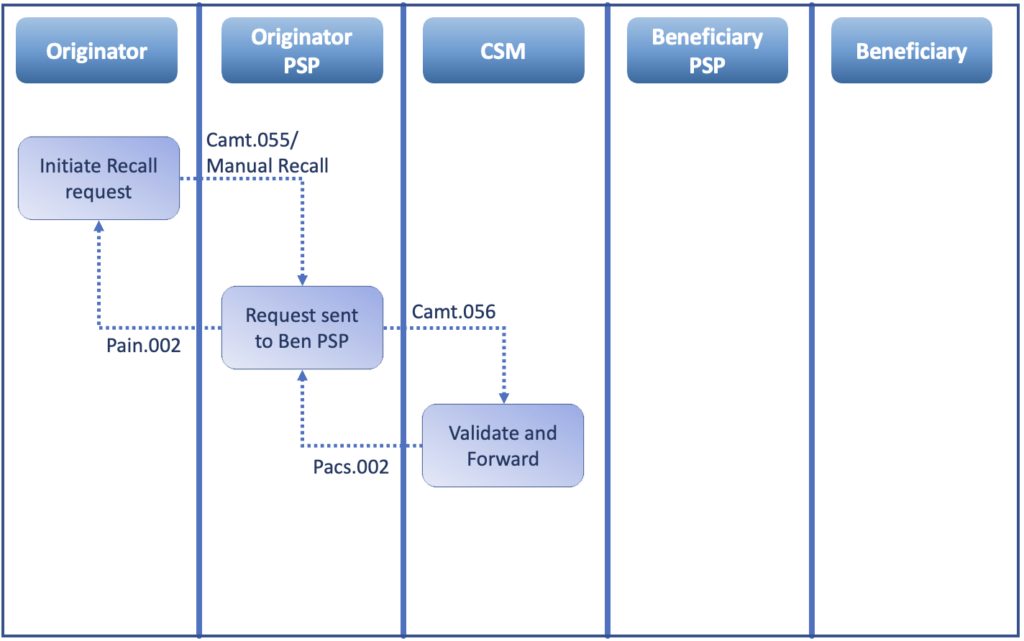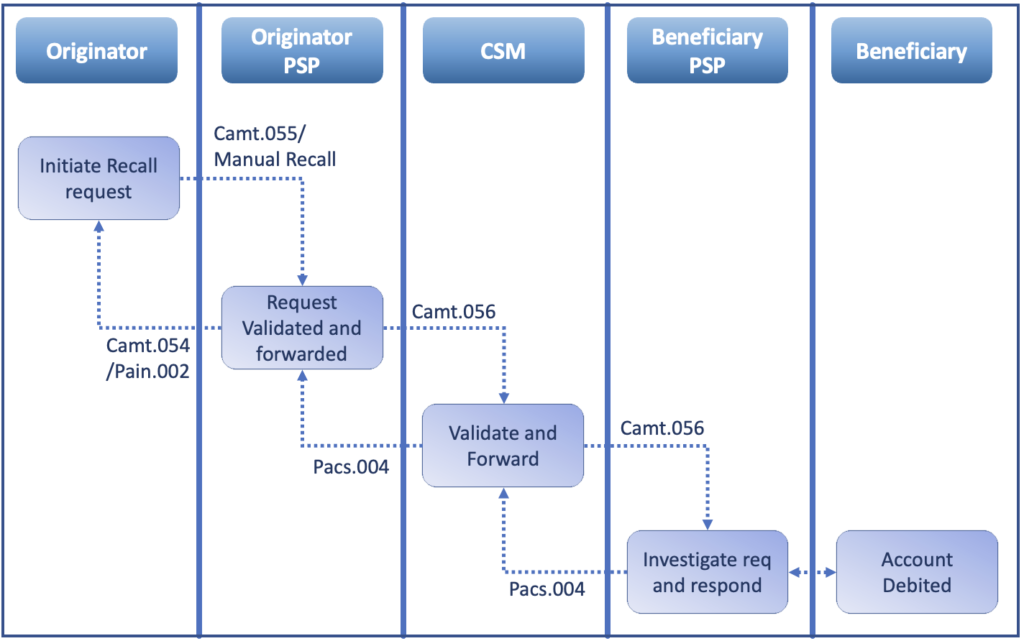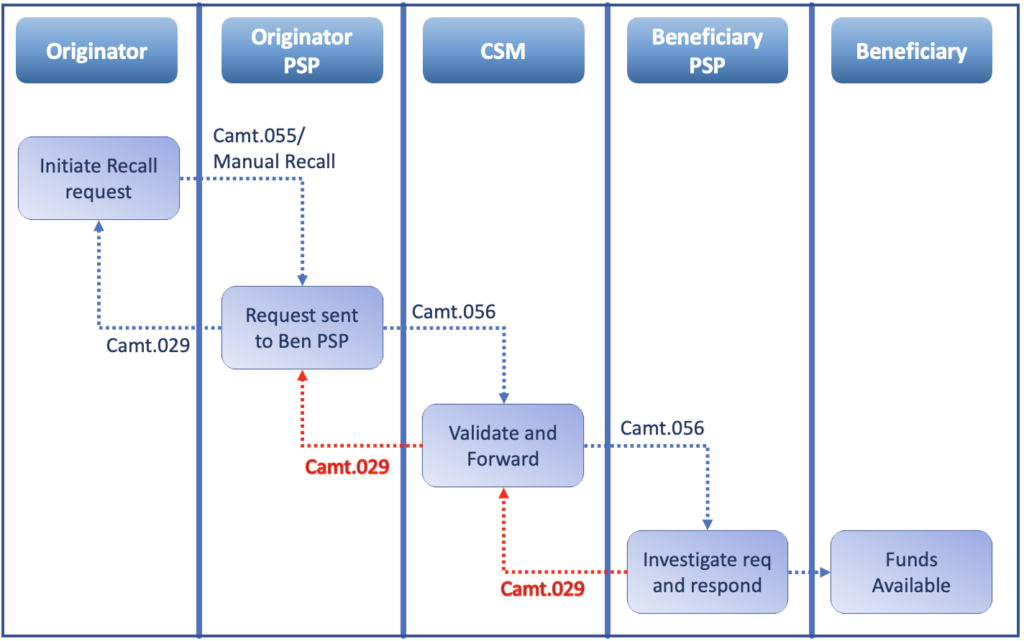Sepa Credit Transfer – Recall flow :
SEPA credit transfer – recall is a process through which an Originator or Originator PSP wants to cancel or get back the funds of an earlier credit transfer that was sent. Both the Originator and the Originator PSP can recall the payment for several reasons and here are some of them
Originator:
- payment sent with incorrect information
- Wrong amount
- Payment sent to the wrong party
Originator PSP:
- A duplicate message sent
- Fraudulent credit transfer message sent
There are different parties in the payment chain and let us see how the different parties react to the recalls. It is important to note that when Originators initiate a recall they communicate to their PSP either via a payment message or email/phone call/branch visit. PSPs on the other hand send a message directly. Whenever an Originator initiates a recall request then it does not guarantee them the funds will be returned.
There are 3 sub-flows within a recall flow:
- Payment not settled
- Positive response to a recall
- Negative response to a recall
The assumption here is that the originating PSP has sent a Pacs.008. Look at this article for more details Happy path.
Payment not Settled (Sepa Credit Transfer – Recall flow):
This is the case where the recall request is sent by the originating PSP to the next party in the payment chain “CSM” and the funds are not yet settled by the CSM.
Step 1: The originator may use a camt.055 or call the bank to initiate the recall with a reason code.
Step 2: The originator PSP validates the request if it comes from the originator, and whether there was a previous Pacs.008 sent, and within the allowed timeline.
Step 3: Originator PSP forwards the request to the CSM as a Camt.056 message after all the validations are successful.
Step 4: The camt.056 message is received by the CSM and since the original Pacs.008 is not yet settled the CSM just cancels the original Pacs.008 and then sends a Pacs.002 to the originator PSP.
Step 5: The originator PSP communicates the status of the original Pacs.008 to the originator via a Pain.002 message.

Positive response to a recall (Sepa Credit Transfer – Recall flow) :
The assumption in this flow is that the original Pacs.008 has been settled and the Beneficiary has received the funds in a .
Step 1: The originator may use a Camt.055 or call the bank to initiate the recall with a reason code.
Step 2: The originator PSP validates the request if it comes from the originator, and whether there was a previous Pacs.008 sent, and within the allowed timeline.
Step 3: Originator PSP forwards the request to the CSM as a Camt.056 message after all the validations are successful.
Step 4: CSM validates that the original Pacs.008 has been successfully settled and forwards the Camt.056 message to the Beneficiary PSP
Step 5: Once the Beneficiary PSP receives the Camt.56 an Investigation ticket is created and the investigation begins.
Step 6: In many countries, the law dictates that the Beneficiary PSP must get the consent of the Beneficiary before debiting their account.
Step 7: Once a positive response is received by the Beneficiary to debit their account the funds are returned in the form of a Pacs.004 message. This Pacs.004 is sent via the same route the original Pacs.008 took but in the opposite direction.
Step 8: The Pacs.004 is processed by the originator PSP and the funds are returned/credit back to the originator.
Step 9: The Originator PSP communicates the return of the funds to the originator through camt.054/pain.002 messages.

Negative response to a recall (Sepa Credit Transfer – Recall flow):
Step 1: Either the originator or originator PSP initiates a recall request. The originator may use a Camt.055 or call the bank to initiate the recall with a reason code.
Step 2: The originator PSP validates the request if it comes from the originator, and whether there was a previous Pacs.008 sent, and within the allowed timeline.
Step 3: Originator PSP forwards the request to the CSM as a Camt.056 message after all the validations are successful.
Step 4: CSM validates that the original Pacs.008 has been successfully settled and forwards the Camt.056 message to the Beneficiary PSP
Step 5: Once the Beneficiary PSP receives the Camt.56 an Investigation ticket is created and the investigation begins.
Step 6: In many countries, the law dictates that the Beneficiary PSP must get the consent of the Beneficiary before debiting their account.
Step 7: If either the beneficiary does not give consent or if there is no response from the beneficiary within the allowed time limit (15 banking days) or if the beneficiary account does not have the balance or other reasons a negative response to the Camt.056 is sent.
Step 8: This negative response is sent in the form of a Camt.029. This Camt.029 takes the same path as the original Pacs.008 but in the opposite direction.
Step 9: Once the negative response is received by the originator PSP then it communicates the same to the originator with a Camt.029.





Blog Comments
Deva Kumar
September 12, 2021 at 8:28 am
Whether you believe it or not you are a good writer. You’re communicating your thoughts in a simple way and it is very easy to understand. Kudos to you!!!!!
Santosh
September 12, 2021 at 9:27 am
Thank you Deva 🙂
Sanjay
September 16, 2021 at 6:23 am
In the positive response case, will there not be any response to camt.056 in the form of camt.028/9 ?
Pacs.004 is a Return of fund, is fair to treat it as response to camt.056?
Santosh
September 16, 2021 at 2:14 pm
I see your point… In the ISO world camt.029 is a resolution to investigation and can have positive or negative response but in SEPA it is sufficient to send the return in order to be compliant … Do let me know if you need further explanation